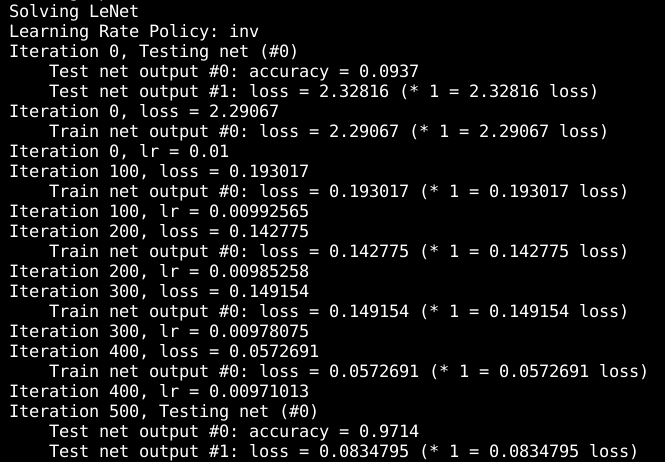作者:mobiledu2502869223 | 来源:互联网 | 2023-01-13 16:55
使用caffe训练模型只需要以下几个步骤:(1)准备好数据;(2)写好模型配置文件;(3)写好优化配置文件;(4)命令行执行;这样就可以得到训练的模型.caffemodel文件了1
使用caffe训练模型只需要以下几个步骤:
(1)准备好数据;
(2)写好模型配置文件;
(3)写好优化配置文件;
(4)命令行执行;
这样就可以得到训练的模型.caffemodel文件了
1.caffe的下载与安装:
(1)下载
(2)安装
(3)caffe的下载与安装以及一些基本的介绍官网已经描述地比较详细,这里不再重复;
2.caffe的使用接口有命令行,python跟matlab,个人觉得训练模型的时候使用命令行已经足够简单了,至于训练好的模型可以使用python与matlab的接口进行调用,本文先描述基于命令行的模型训练,以LeNet模型为例;
LeNet模型

PS:LeNet是手写数字库MNIST上应用比较经典的模型,具有7层网络结构,分别是卷积-下采样-卷积-下采样-全连-全连-分类层,具体网络细节可以参考文章:
Gradient based learning applied to document recognition
1.安装编译完caffe后,其主目录下有:

2.训练模型之前需要先准备好训练数据MNIST,执行以下命令可以下载MNIST数据库:

3.由于caffe支持的数据类型不包括图像类型,所以常规做法需要将图像类型转为lmdb类型:

4.准备好数据之后,我们需要定义我们的网络模型,在caffe中是通过.prototxt配置文件来定义的,执行以下命令:

可以看到各个网络层是如何定义的:
(1)输入层(数据层):
-
layer {
-
name: "mnist" //表示层名
-
type: "Data" //表示层的类型
-
top: "data"
-
top: "label"
-
include {
-
phase: TRAIN //表示仅在训练阶段起作用
-
}
-
transform_param {
-
scale: 0.00390625 //将图像像素值归一化
-
}
-
data_param {
-
source: "examples/mnist/mnist_train_lmdb" //数据来源
-
batch_size: 64 //训练时每个迭代的输入样本数量
-
backend: LMDB //数据类型
-
}
-
}
(2)卷积层:
-
layer {
-
name: "conv1"
-
type: "Convolution"
-
bottom: "data" //输入是data
-
top: "conv1" //输出是卷积特征
-
param {
-
lr_mult: 1 //权重参数w的学习率倍数
-
}
-
param {
-
lr_mult: 2 //偏置参数b的学习率倍数
-
}
-
convolution_param {
-
num_output: 20
-
kernel_size: 5
-
stride: 1
-
weight_filler { //权重参数w的初始化方案,使用xavier算法
-
type: "xavier"
-
}
-
bias_filler {
-
type: "constant" //偏置参数b初始化化为常数,一般为0
-
}
-
}
-
}
(3)下采样层(pool):
-
layer {
-
name: "pool1"
-
type: "Pooling"
-
bottom: "conv1"
-
top: "pool1"
-
pooling_param {
-
pool: MAX
-
kernel_size: 2
-
stride: 2
-
}
-
}
(4)全连层:
-
layer {
-
name: "ip1"
-
type: "InnerProduct"
-
bottom: "pool2"
-
top: "ip1"
-
param {
-
lr_mult: 1
-
}
-
param {
-
lr_mult: 2
-
}
-
inner_product_param {
-
num_output: 500
-
weight_filler {
-
type: "xavier"
-
}
-
bias_filler {
-
type: "constant"
-
}
-
}
-
}
(5)非线性层:
-
layer {
-
name: "relu1"
-
type: "ReLU"
-
bottom: "ip1"
-
top: "ip1"
-
}
(6)准确率层(计算准确率):
-
layer {
-
name: "accuracy"
-
type: "Accuracy"
-
bottom: "ip2"
-
bottom: "label"
-
top: "accuracy"
-
include {
-
phase: TEST
-
}
-
}
(7)损失估计层:
-
layer {
-
name: "loss"
-
type: "SoftmaxWithLoss"
-
bottom: "ip2"
-
bottom: "label"
-
top: "loss"
-
}
5.定义完网络模型,还需要配置关于模型优化的文件:

配置文件如下:
-
# The train/test net protocol buffer definition
-
net: "examples/mnist/lenet_train_test.prototxt" //设定网络模型配置文件的路径
-
# test_iter specifies how many forward passes the test should carry out.
-
# In the case of MNIST, we have test batch size 100 and 100 test iterations,
-
# covering the full 10,000 testing images.
-
test_iter: 100
-
# Carry out testing every 500 training iterations.
-
test_interval: 500
-
# The base learning rate, momentum and the weight decay of the network.
-
base_lr: 0.01
-
momentum: 0.9
-
weight_decay: 0.0005
-
# The learning rate policy
-
lr_policy: "inv"
-
gamma: 0.0001
-
power: 0.75
-
# Display every 100 iterations
-
display: 100
-
# The maximum number of iterations
-
max_iter: 10000
-
# snapshot intermediate results
-
snapshot: 5000
-
snapshot_prefix: "examples/mnist/lenet"
-
# solver mode: CPU or GPU
-
solver_mode: GPU
6.接下来一步就是进行训练了,直接执行命令就可以:

执行后可以看到:首先会读取配置文件初始化网络跟优化器:

紧接着开始优化:

可以看到训练过程中每100次迭代就会显示一个loss,每500次迭代就会计算一次test准确率,总共10000次迭代,这些都可以在配置文件中设置;
7.训练完之后的模型就保存在.caffemodel文件中,该文件可以被c,python,matlab等调用;